Intermarkets' Privacy Policy
Donate to Ace of Spades HQ!
aceofspadeshq at gee mail.com
Buck:
buck.throckmorton at protonmail.com
CBD:
cbd at cutjibnewsletter.com
joe mannix:
mannix2024 at proton.me
MisHum:
petmorons at gee mail.com
J.J. Sefton:
sefton at cutjibnewsletter.com
Daily Tech News 19 January 2026
Sunday Overnight Open Thread - January 18, 2026 [Doof]
Gun Thread: Third January Edition!
Food Thread: Render Unto Yorkshire (Pudding) The Things That Go With Yorkshire (Pudding)
First World Problems...
Greenland, NATO, The EU...The Clownshow Continues
Sunday Morning Book Thread - 1-18-2026 ["Perfessor" Squirrel]
Daily Tech News 18 January 2026
Saturday Night Club ONT - January 17, 2026 [Double Play]
Jim Sunk New Dawn 2025
Jewells45 2025
Bandersnatch 2024
GnuBreed 2024
Captain Hate 2023
moon_over_vermont 2023
westminsterdogshow 2023
Ann Wilson(Empire1) 2022
Dave In Texas 2022
Jesse in D.C. 2022
OregonMuse 2022
redc1c4 2021
Tami 2021
Chavez the Hugo 2020
Ibguy 2020
Rickl 2019
Joffen 2014
maildrop62 at proton dot me
TBD
Saturday Gardening Thread: The Color Purple [KT]
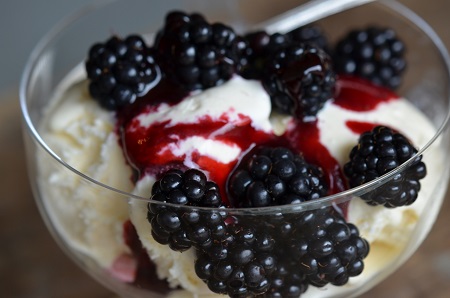
This week, I ran across a great motivational article about growing blackberries with less pain. And a butterfly organization pegged mauve and yellow as the favorite colors of many butterflies. This got me thinking about the color purple. Is mauve a shade or tint of purple? When you say "purple", what is the first color you actually think of?
In the gardening world, many purplish flowers or leaves are called either "blue" or "red". Or even "black". Why is that? Conversely, have you ever wondered why there are so many songs with "purple" in the title? O.K., I know I have a hole in my cultural literacy here. I understand "blue" being in the title of songs, but why "purple"? Deep Purple, Purple Haze, Purple Rain, etc. Have you ever seen really purple rain? Do gardening people look at the world differently than music people? Something to think about as you read about this week's plants.
Should you grow your own blackberries?
Whilst waiting for a friend at an AT&T store, a piece by Lee Reich about growing blackberries came up unbidden on one of their displayed iPads. It was about growing blackberries without the blood. I figured that this was a sign that someone in The Horde was thinking about planting blackberries.
Blackberries grow wild in many parts of the country. Foragers in The Horde can attest to the tastiness of most of these wild berries, even from the nasty, pestifrous Himalayan and Evergreen Blackberries.
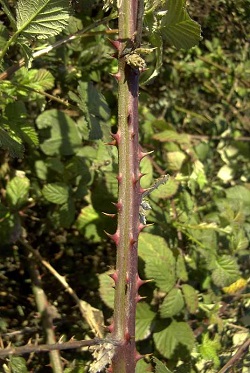
But many garden cultivars are better. From the Reich article:
Growing blackberries can be intimidating because of their thorns. Most blackberry plants are thoroughly armed, even on their leaves, with ferocious thorns that grab, stab and hold you.Many gardeners are willing to put up with the pain because the fruit is so delicious.
Not I. I grow thorn-less varieties of blackberries, horticultural wonders with pretty much all the qualities of their thorny relatives except the thorns.
And why should you grow your own?
Most important is that each blackberry hangs on the plant just beyond its showy, glossy black stage, until it is dead ripe. At that point, blackberries are dull black, as if sullenly crying out to be plucked, an impression reinforced by their readiness, at the slightest suggestion, to part from their stalks and stain the fingertips.To withstand the rigors of shipping, commercial blackberries are picked when black but still firm -- and tart. Fruit allowed to develop full flavor on the plant cannot tolerate being carried more than about 3 feet, the distance from hand to mouth.
Basic instructions for growing and pruning blackberries follow. If you are in the West, I would recommend checking out the variety descriptions in the latest Sunset Western Garden Book. They classify cultivars into trailing Western types, generally hardier Midwestern and Eastern upright types and semi-erect types. Consider disease resistance. You might want to grow early, midseason and late types.
I am personally glad that Boysenberries, Loganberries and Youngberries come in thornless versions now. 'Black Diamond' is classified as a thornless Marionberry type.
Do you have a favorite blackberry (or blackberry hybrid) cultivar? Does it have thorns?
There are also a few new "primocane" types that bear fruit at the tips of branches on new growth, like everbearing raspberries. If you are willing to forego the first crop of the summer (from year-old wood) you can mow the plants to the ground every year instead of pruning them.
Are blackberries purple? Is this ice cream a bluer shade of purple than this ice cream, and if so, why? Maybe the berries had different phytonutrient contents. Antioxidants and other nutrients vary by cultivar.
Those who must eat under-ripe, store-bought berries may console themselves with the thought that, at least in the case of blackberries and strawberries, antioxidant content is highest at the green stage. Of the fruits in one trial, black raspberries and (thornless) blackberries had the highest antioxidant content at the ripe stage. You know, when you would actually want to eat them. If you can't grow your own, a farmers market is the next best choice, especially for delicate berries like boysenberries.
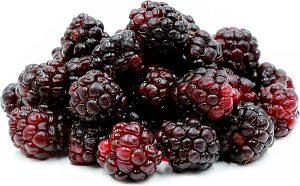
Purple flowers that attract butterflies
There has been some discussion in the comments recently about flowers to attract butterflies. One of the most famous of these is the Butterfly Bush, Buddleja (or popularly, Buddleia) davidii. It is getting to be about time to plant or prune these in some parts of the country. There are other plant in this genus that also attract butterflies. Maybe you would like to grow one of those.
Is it legal to say "Butterfly Bush" in Oregon?
Well, you can say the words, but you can't sell a butterfly bush as a "Butterfly Bush". The ones that are legal must be sold as "Summer Lilac" or "Seedless Butterfly Bush" or something. That's because B. davidii has become invasive in parts of Washington and Oregon. Sort of like Himalayan and Evergreen Blackberries. You gotta change your evil ways, baby.
Another species, the powerfully-fragrant, winter-blooming B. asiatica, has colonized moist lava fields in Hawaii. After it flowers, the seed heads turn kind of an ugly brown. The local name for this plant in Hawaii is dog tail. Scroll down to see why you should dead-head spent blooms on this plant. Especially where it is invasive.
Sunset lists it for my zone (in the Central Valley of California). But it is very tender to frost. The Mountain Valley Growers site carries some other unusual Buddleia species and hybrids, like Orange Sceptre, "everblooming in our zone", attractive to both hummingbirds and butterflies. Not a real looker from a distance, but if you're in a mild-winter area and want to attract some winged creatures . . . .
But back to the Northwest: Here's a discussion of butterfly bushes that are legal in Oregon. One of the first cultivars legalized is Miss Ruby, described as nearly seedless. She is larger than her little brother, Blue Chip LO AND BEHOLD, "small enough to be used as a flowering ground cover or in containers". They were both bred at the JC Raulston Arboretum at NCSU. There is also a Blue Chip Jr.
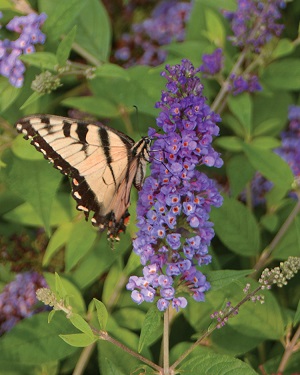
Evidently, most of these non-invasive cultivars come from complex inter-species crosses, like Buddleja (B.davidii x (B. davidii x B. globosa)) x (B. davidii x B. globosa) 'Miss Ruby'. Doesn't that white hydrangea pop the color? Anybody know which species of hydrangea it is?

There is also a Miss Molly. She is also approved for sale in Oregon and Washington, but "Fragrant flowers are a rich sangria-red color. Red color may be more pronounced in the South." The South will rise again. Good golly.
Buddleia pikei 'Hever Castle' is an older interspecies hybrid that blooms in early spring where it doesn't die back to the ground in winter. It is legal in Oregon.
Hever Castle was the childhood home of Anne Boleyn who was queen of England in the 1500s and was beheaded by King Henry the 8th. Today this historic castle is the home of a marvelous English garden and this beautiful butterfly bush.
This style of topiary seems kind of menacing to me. It kind of fits in with the home of a woman whose head was later cut off:

Butterfly Bushes Outside Oregon and Washington
There is additional controversy in the plant world about whether you should plant non-native Buddlejas to attract butterflies. Rodale takes an absolutist stance against butterfly bushes in the USA. WHAT ABOUT THE CATERPILLARS?
Butterfly Gardener takes on the great butterfly bush debate in a special issue. The PDF is in a double-page format, so it might be hard to read from a phone, but it includes a lot of information. The "native only" view is balanced by another piece by a Midwest butterfly gardener:
. . . Butterflies easily access the copious nectar with a high concentration of sucrose. Reportedly, even the sterile hybrids are nectar-rich, but my experience is limited to the Buddleja davidii species, since my less vigorous hybrids died long ago in this unforgiving Kansas climate.Native Plant Absolutists gnash their teeth in frustration, but butterflies are not ideologues. They are pragmatists at the molecular level. If their foot's chemical receptor and the molecule match, the plant's origin is irrelevant. Why be so rigid? Our Regional Director of the Kansas Native Plant Society has a greenhouse and raises hundreds of butterfly bushes to sell at area Master Gardener plant sales. My sense of justice is offended by Americans who eat predominantly non-native foods, but would refuse that same pleasure to butterflies.
Heh. Remember to deadhead your butterfly bush if you live in an area where seedlings escape into the wild.
Little Butterfly Bushes
Here is a typical plant of one of the newer dwarf butterfly bushes. You can get Lilac Chip via the AoSHQ Amazon Store. Would you consider growing it as a tall ground cover? Maybe with a couple of companion plants?
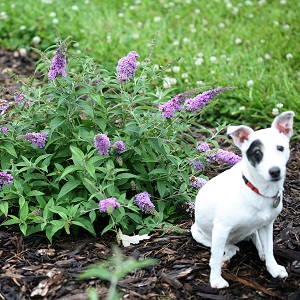
I've always thought the flowers on most butterfly bushes looked sort of . . . droopy. Why not take them all the way from "droopy" to "weeping"? Wisteria Lane seems like a good choice for large containers. Might require some extra winter protection in the North if grown in pots. It would also be nice draped over a low retaining wall. Listed as hardy to Zone 5. Reportedly does well in hot Texas sun. I've seen it described as 2' x 2' up to 5' x 5' (in the ground). What would you grow near it?

Medium-sized to big butterfly bushes
Here some pruning advice for regions where B. davidii does not freeze to the ground in winter:
Buddleias need savage pruning, especially the taller varieties, and this should be carried out in late winter or early spring. Pruning in autumn may result in the death of your plant. Cut away the previous years growth to two or three buds from their base. Unless you want to remove a branch entirely, to reshape buddleia, do not cut back into the older wood, which is usually thicker and darker coloured, as this may not readily sprout new shoots. The pruned shrub will have a low framework of branches from which shoots will grow rapidly to produce flowers in summer. If you're dealing with an overgrown buddleia take one half down in one year ( in March) and the second half in the following year (again in March).
Butterfly bushes come in a wide range of colors. Some have variegated foliage that look especially nice in afternoon shade. Perhaps the most famous of the older cultivars is Black Knight. It does have a distinctive purple color, but the flower form is not my favorite.
Dartmoor, my favorite big butterfly bush
Dartmoor is the only butterfly bush I know of that has branched flower heads. It looks more like a lilac than other butterfly bushes do. It has an interesting history. From a Canadian site:
This fantastic butterfly bush has giant clusters of warm purple flowers that dwarf all other cultivars. The plant that was to become Buddleia 'Dartmoor' was found in Devon in 1971 by Mr. Hayles, a retired gardener. Walking with his wife he spied an unusual buddleja flowering on the edge of a ravine. With his trustworthy wife clinging onto him, Hayles valiantly reached down to collect a few branches. 'Dartmoor' was released to the gardening public just a few years later.
Dartmoor is for people who want a big shrub that will attract a lot of butterflies. If left unpruned, it can reportedly reach 16 feet in friendly climates. Best with some spring pruning, which increases branching of the flowers.
A couple in the UK set out to determine which kind of butterfly bush was most attractive to the local butterflies. Of the 211 plants surveyed (some not yet mature) Dartmoor was the cultivar which attracted the most butterflies the first year of the trial. Volunteer butterfly recorders visited over several months. Quite a project!

Another favorite of butterflies in the trial above was 'Autumn Beauty' (lavender, good for planting near schools, as it is still in bloom when school starts). 'White Profusion' did pretty well with the butterflies, too. Yellow to orange B. weyeriana was not the most popular plant with butterflies during the trial, but bloomed very late into the season.
Rock Cress and other purple butterfly flowers
The organization for which the "most attractive Buddleia" survey was done recommmended some other plants with little purple flowers as butterfly nectar sources. These include Aubrieta, Sweet Rocket (hesperis matronalis), Perennial Wallflower (Erysimum 'Bowles Mauve'), and Verbena bonariensis.
A garden writer for the Sunday Express is apparently doing a "Purple Haze" series, with advice on growing plants like lavender. About Aubretia, he wrote:
Do you remember when every front garden had a rockery? When each year in late March and April these mini Mont Blancs would erupt with a brilliance that took you by surprise?The reason was that they were planted with one of the most obliging carpeters ever known to man – aubrieta.
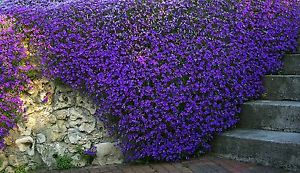
When I was growing up, one our our neighbors had a bank of aubrieta rising from their driveway to the upper level of their split-level home. It was spectacular in spring. Didn't notice it much the rest of the year.
Aubrieta comes in several colors from pink to rose to purple to purple-blue. It is available both as cutting-grown named varieties and as pretty nice seed strains.
You might think that Bowles Mauve Wallflower would also fall over sleepy garden walls, but it is quite upright. The famous fragrant biennial wallflowers do best in cool summer climates. Bowles Mauve will survive in Central California, but not in the desert, except as a winter annual. It has a very long season of bloom in cool-summer areas. Here, it blooms from winter into spring and does not live very long.
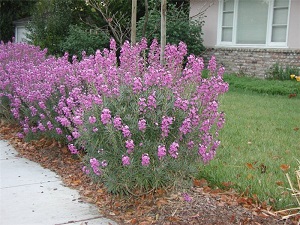
Gardens of The Horde
Last week in the comments, nice things were said about the dramatic Ocotillo for the Desert Southwest. This plant can be breathtaking when backlit at night. Our Butterfly Gardener reference today turned up a native Butterfly Bush which could be a good partner for Ocotillo in the garden, the Woolly Butterfly Bush. They both provide nectar for hummingbirds. The Butterfly Bush blooms later. The Ocotillo gets much larger, so eventually the Butterfly Bush would be a foreground plant. What do you desert denizens think?
Here is a bloom detail for the Woolly Butterfly Bush.
Some members of The Horde are interested in growing plants for butterflies and hummingbirds from seed. Often, heirloom selections make the best choices. Two good sources are Diane's Flower Seeds and Select Seeds (seeds and plants). The latter has an interesting search function that allows you to choose characteristics you want in the plants you choose.
CORRECTION: A few weeks ago, I noted that, once again, I had been unable to locate the order form for the Crosman Seed Company. But this time, it is because they had started online ordering with a shopping cart and everything. Didn't occur to me to check, because of past experience. In other words, profiling. If you want to order some cheap seeds to attract butterflies and hummingbirds, they have several time-tested selections. The tall annual Phlox, Balsam and Mourning Bride (annual Scabiosia) are kind of unusual today. They have a good selection of Zinnias. While you're at it, you might want to order some Romanette Green Beans and Fordhook limas (if you like limas). A nice site if you want to send some seeds to a kid just starting to garden.
Diane's has lists of butterfly and hummingbird flowers. Diane notes that in addition to having flowers that attract hummingbirds and many butterflies, Verbena bonariensis is one of the host plants for the Common Buckeye Butterfly.
Resident in the southern United States and north along the coasts to central California and North Carolina; south to Bermuda, Cuba, Isle of Pines, and southern Mexico. Adults from the south's first brood migrate north in late spring and summer to temporarily colonize most of the United States and parts of southern Canada.
A gardener in Virginia noted one August:
I was just astounded at the number of nectar-sippers hovering around the Verbena bonariensis this weekend in the country. Just in casual observation, I counted at least six different species of butterflies - Tiger Swallowtail (both light and dark forms), Spicebush Swallowtail, American Lady, Zabulon Skipper, other skippers (names still elude me - sorry), and a new one for me: the Common Buckeye. If it's so common, how come I never saw one until this weekend?
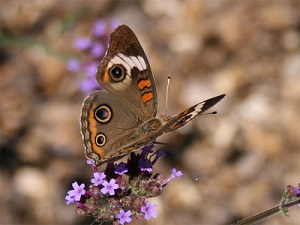
V. bonariensis creates an airy purple haze among other plants in the garden. Although the flower stalks get quite tall, it can be used in the foreground of a border as well as in the background, because you can see through the plant.
Don't kill those slightly spiky little caterpillars on your verbena, snapdragons or ruellia.

Here in the Valley, tomato and pepper plants are starting to appear in nurseries. Gotta get going. What's happening in your garden world?
Hope you have a great week.
man: "If Britain Bans X, How Far Will It Go To Block Fre ..."
weft cut-loop[/i][/b] [/s]: "Something's screwed on Twitter. The 'top' comments ..."
Huck Follywood: "Posted by: JROD at January 19, 2026 07:52 AM (IlL6 ..."
fd: "If somebody would put Springsteen in a black Excur ..."
LinusVanPelt : "Lula da Silva can EABOD… that is all ..."
Ian S.: "From the mouths of foul-mouthed rappers: [I]Nic ..."
Huck Follywood: "Being a Democrat might just disqualify people from ..."
Biff Pocoroba: "A century and a half ago, the socialist Commune to ..."
JROD: "Not an attack on JJ. I'm not putting this all on T ..."
man: "Minneapolis is what you get when you are more conc ..."
Mardi Gras crews in Mobile and New Orleans : "*Video of a "protester" dressed as a Viking sittin ..."
Daily Tech News 19 January 2026
Sunday Overnight Open Thread - January 18, 2026 [Doof]
Gun Thread: Third January Edition!
Food Thread: Render Unto Yorkshire (Pudding) The Things That Go With Yorkshire (Pudding)
First World Problems...
Greenland, NATO, The EU...The Clownshow Continues
Sunday Morning Book Thread - 1-18-2026 ["Perfessor" Squirrel]
Daily Tech News 18 January 2026
Saturday Night Club ONT - January 17, 2026 [Double Play]
Paul Anka Haiku Contest Announcement
Integrity SAT's: Entrance Exam for Paul Anka's Band
AllahPundit's Paul Anka 45's Collection
AnkaPundit: Paul Anka Takes Over the Site for a Weekend (Continues through to Monday's postings)
George Bush Slices Don Rumsfeld Like an F*ckin' Hammer
Democratic Forays into Erotica
New Shows On Gore's DNC/MTV Network
Nicknames for Potatoes, By People Who Really Hate Potatoes
Star Wars Euphemisms for Self-Abuse
Signs You're at an Iraqi "Wedding Party"
Signs Your Clown Has Gone Bad
Signs That You, Geroge Michael, Should Probably Just Give It Up
Signs of Hip-Hop Influence on John Kerry
NYT Headlines Spinning Bush's Jobs Boom
Things People Are More Likely to Say Than "Did You Hear What Al Franken Said Yesterday?"
Signs that Paul Krugman Has Lost His Frickin' Mind
All-Time Best NBA Players, According to Senator Robert Byrd
Other Bad Things About the Jews, According to the Koran
Signs That David Letterman Just Doesn't Care Anymore
Examples of Bob Kerrey's Insufferable Racial Jackassery
Signs Andy Rooney Is Going Senile
Other Judgments Dick Clarke Made About Condi Rice Based on Her Appearance
Collective Names for Groups of People
John Kerry's Other Vietnam Super-Pets
Cool Things About the XM8 Assault Rifle
Media-Approved Facts About the Democrat Spy
Changes to Make Christianity More "Inclusive"
Secret John Kerry Senatorial Accomplishments
John Edwards Campaign Excuses
John Kerry Pick-Up Lines
Changes Liberal Senator George Michell Will Make at Disney
Torments in Dog-Hell
The Ace of Spades HQ Sex-for-Money Skankathon
A D&D Guide to the Democratic Candidates
Margaret Cho: Just Not Funny
More Margaret Cho Abuse
Margaret Cho: Still Not Funny
Iraqi Prisoner Claims He Was Raped... By Woman
Wonkette Announces "Morning Zoo" Format
John Kerry's "Plan" Causes Surrender of Moqtada al-Sadr's Militia
World Muslim Leaders Apologize for Nick Berg's Beheading
Michael Moore Goes on Lunchtime Manhattan Death-Spree
Milestone: Oliver Willis Posts 400th "Fake News Article" Referencing Britney Spears
Liberal Economists Rue a "New Decade of Greed"
Artificial Insouciance: Maureen Dowd's Word Processor Revolts Against Her Numbing Imbecility
Intelligence Officials Eye Blogs for Tips
They Done Found Us Out, Cletus: Intrepid Internet Detective Figures Out Our Master Plan
Shock: Josh Marshall Almost Mentions Sarin Discovery in Iraq
Leather-Clad Biker Freaks Terrorize Australian Town
When Clinton Was President, Torture Was Cool
What Wonkette Means When She Explains What Tina Brown Means
Wonkette's Stand-Up Act
Wankette HQ Gay-Rumors Du Jour
Here's What's Bugging Me: Goose and Slider
My Own Micah Wright Style Confession of Dishonesty
Outraged "Conservatives" React to the FMA
An On-Line Impression of Dennis Miller Having Sex with a Kodiak Bear
The Story the Rightwing Media Refuses to Report!
Our Lunch with David "Glengarry Glen Ross" Mamet
The House of Love: Paul Krugman
A Michael Moore Mystery (TM)
The Dowd-O-Matic!
Liberal Consistency and Other Myths
Kepler's Laws of Liberal Media Bias
John Kerry-- The Splunge! Candidate
"Divisive" Politics & "Attacks on Patriotism" (very long)
The Donkey ("The Raven" parody)

